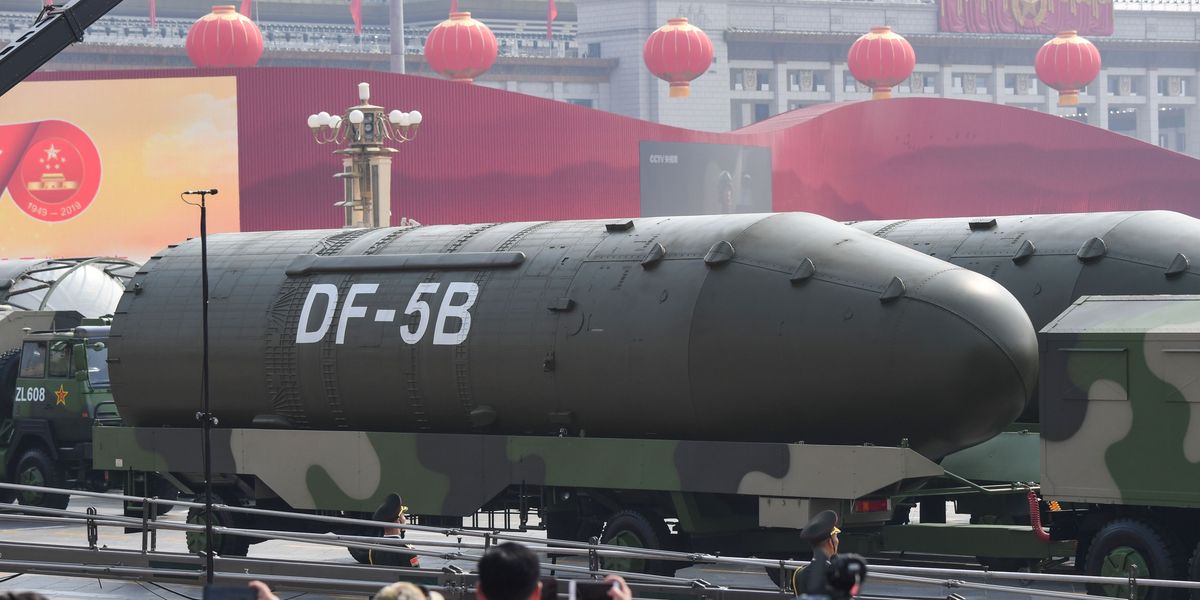- Home
- Advertise With us
- World News
- Tech
- Entertainment
- Travels & Tours
- Contact US
- About us
- Privacy Policy
Top Insights
Beijing’s Rare Disclosure on DF-5B Missile Signals Shift in Nuclear Messaging


CIPHER BRIEF REPORTING — China’s state television put a rare public focus on Beijing’s DF-5B intercontinental ballistic missile earlier this month, revealing key details that mark a significant shift in Beijing’s nuclear messaging amid rising global tensions and in the midst of unraveling key arms control agreements.
According to state broadcaster CCTV, the upgraded DF-5B missile is reportedly capable of carrying up to 10 independently targetable warheads, each with a destructive yield estimated to be 200 times more powerful than the Hiroshima bomb. Exact figures remain difficult to verify, as independent assessments vary. But CCTV claims that the missile’s range is approximately 12,000 kilometers (7,460 miles), putting most of the continental United States and Europe within reach. So, why does this matter?
While the details of the DF-5B match some already disclosed details, the notion that state television is putting such a public focus on this is “unusual and perhaps speaks to a willingness on China’s part to begin signaling its nuclear growth in a more public manner,” according to Matt Korda, Associate Director at the Federation of American Scientists’ Nuclear Information Project.
“China has not traditionally commented on the details of its weapon systems and instead almost always sticks to high-level talking points. Perhaps this portends a shift in the country’s communications strategy,” Korda, who also serves as Associate Senior Researcher for the Stockholm International Peace Research Institute’s Weapons of Mass Destruction Program, tells The Cipher Brief.
While the original DF-5 missile, developed during the Cold War, was outfitted with a single warhead, the DF-5B’s multi-warhead capacity—alongside its purported accuracy within 500 meters— represents a significant leap in China’s second-strike capability and nuclear survivability.
Andrew Erickson, a professor of strategy at the Naval War College and visiting China-focused scholar at Harvard University, believes that the renewed focus on this issue “is part of a comprehensive effort to attempt to coerce and intimidate its adversaries regarding the military scenarios about which Beijing prioritizes most.”
“Beijing’s goal is to show that it can match or exceed its adversaries on each rung of the escalation ladder; and also has the capability to utilize rungs, or combination of rungs, that its adversaries either do not possess or are more hesitant to use,” he explained.
Andrew Scobell, Distinguished Fellow for China at the United States Institute of Peace, said, “China’s communist rulers are feeling more insecure than usual, and this disclosure is their way of signaling ‘don’t mess with Beijing’ to Washington and other capitals.”
“The message is: China’s nuclear weaponry and delivery systems are more capable today than ever before with a longer reach and greater accuracy,” he tells The Cipher Brief.
A Rapidly Expanding Arsenal
China’s nuclear arsenal remains smaller than those of Russia or the United States, but it is growing at an unprecedented rate. The Stockholm International Peace Research Institute (SIPRI) reports that China has increased its warhead count by about 100 in the past year, rising from 500 in 2024, to over 600 by January 2025.
The SIPRI report notes that China is “expanding its nuclear arsenal faster than any other nuclear-armed state.” Experts estimate that by 2035, if current trends continue, China could possess as many as 1,500 nuclear warheads—a threefold increase that would still place it behind the United States and Russia, which together hold nearly 90 percent of the global stockpile.
But Multiple Independently target-able Reentry Vehicles (MIRVs) —allow a single missile to carry several nuclear warheads, each aimed at a different target. This dramatically complicates interception, as the warheads can overwhelm defenses by arriving on separate trajectories, making coordinated response far more difficult and costly.
The Cipher Brief Threat Conference is happening October 19-22 in Sea Island, GA. The world’s leading minds on national security from both the public and private sectors will be there. Will you? Apply for a seat at the table today.
“Current U.S. missile defenses are unable to meaningfully defend against Chinese ICBMs, whether they carry multiple warheads or not,” Korda said. “Having MIRVs certainly complicates that challenge and demonstrates the age-old problem for missile defenses: that offense will always be easier and cheaper than defense.”
Erickson believes that China’s criticism of U.S. missile-defense efforts like the Golden Dome, “and collaboration with Moscow on hypocritical arms control grandstanding rings hollow when Beijing remains silent on, or tacitly condones, Russia’s development of dramatic space control measures,” the most worrisome and threatening of which, is what would be the world’s first satellite-based nuclear weapon according to Erickson.
Projections derived from open-source satellite information and imagery, published in the Bulletin of the Atomic Scientists, note that China has nearly completed close to 350 new ICBM silos that are spread across multiple deserts and mountainous regions, including in Gansu and Inner Mongolia. Depending on deployment strategies, this could enable China to deploy several ICBMs comparable to those of Russia or the United States by the decade’s end.
Implications for Deterrence and Stability
China’s shift comes as the framework for nuclear arms control faces significant strain. With New START, the last remaining treaty limiting Russian and U.S. strategic nuclear arsenals, set to expire in early 2026, and no successor agreement in place, the global arms control architecture appears increasingly obsolete.
Some experts warn that the world is effectively entering an era of unchecked nuclear competition and worry that the growing deployment of artificial intelligence, space-based sensors, and cyber capabilities could erode crisis stability and introduce new pathways to escalation.
Advanced systems can compress decision-making time and increase the risk of miscalculation or technical error, particularly in multi-theater conflict scenarios involving China and Russia. According to SIPRI, “the signs are that a new arms race is gearing up that carries much more risk and uncertainty than the last one.”
Strategic Consequences for the West
The implications of China’s buildup extend far beyond Asia. Despite Russia and the United States’ decades-long atomic dominance, China’s rapidly expanding nuclear missile arsenal indicates a profound shift in global strategic dynamics.
For the West, experts emphasize that China’s nuclear buildup is raising the stakes of deterrence and complicates arms control efforts. It also demands an urgent reassessment of defense postures—particularly as Beijing builds a more flexible, survivable, and modernized nuclear triad – the ability to launch nuclear weapons from land-based missiles, submarine-launched missiles, and strategic bombers. This capability enables Beijing to more credibly challenge Western military presumptions.
“Advanced nuclear weapons and delivery systems are the ultimate backstop supporting Beijing’s efforts to impose a Sisyphean sense of futility on its enemies while supporting the ultimate warfighting options should that preferred approach ultimately fail to deliver,” Erickson said.
Analysts with the Federation of American Scientists have observed that China’s expanded ICBM infrastructure enables more flexible deployment, blending fixed silos with mobile launchers and dual-use capabilities, which complicate both detection and preemption. And as the U.S. continues to serve as the primary security guarantor for Europe and the Indo-Pacific, it faces the potential challenge of confronting multiple nuclear-capable adversaries simultaneously. For example, if drawn into parallel conflicts—such as a war in Ukraine and a Taiwan Strait crisis—experts worry that its conventional forces could become overstretched, increasing a reliance on nuclear deterrence.
The Next Phase of the Nuclear Race
DF-5B represents more than just a technical advancement for Beijing; it is a calculated message to the world. China’s modernization efforts are now a tangible reflection of the leadership’s ambition to move closer to nuclear parity—particularly in capability and survivability—with the United States and Russia.
With arms control faltering and nuclear parity drawing near, the world is poised for a new era of strategic competition, marked by high stakes, blurred red lines, and faster-moving threats. So, what can Washington do?
Sign up now for The Cipher Brief Nightcap. The best M-F national security newsletter keeping you up to speed on the most pressing issues of the day. Sign up today.
Scobell notes that, “America and its allies should reevaluate their deterrence strategies,” pointing out that integrated deterrence sounds good in theory but putting it into action is tougher—especially because it must work across different areas like nuclear and conventional weapons. Deterring China is already a complex endeavor that is made even more challenging in today’s tense U.S.-China environment.
Korda believe that engaging China in arms control talks will be challenging, as Beijing would “have to accept some degree of transparency to join a verifiable arms control regime, and it has traditionally preferred to rely on opacity to safeguard its smaller nuclear arsenal.”
“In addition, China is likely concerned that the United States––particularly through its ever-expanding missile defense architecture, is seeking to erode its state of mutual vulnerability with its nuclear adversaries,” he said.
According to Korda, China likely perceives time to be on its side as it continues to expand its nuclear arsenal and “will likely wait to engage in significant talks until it gains the leverage it thinks it needs to become a more equal negotiating partner.”
Erickson contends that Beijing’s strategic ambiguity remains central to its doctrine: a tactic and a message.
“China doesn’t want us to understand their deterrence strategy; that lack of clarity is baked into the ambiguity,” he notes. “For twenty years of dialogue on these issues, the Chinese government and Chinese experts outside of government did not engage meaningfully. I don’t believe the PLA wants us to understand them.” Still, others see it differently.
“Conventional wisdom in Washington holds that nuclear arms control is dead, but I do not agree. Russia is eager to get into a new agreement, especially if that was coupled with a new overall concept for security in Europe,” Lyle Goldstein, Director for Asia Engagement at Defense Priorities, tells The Cipher Brief. “I believe that Beijing could be persuaded too if afforded the right set of enticing ‘carrots,’ such as a U.S. agreement to a no-first-use accord.”
Are you Subscribed to The Cipher Brief’s Digital Channel on YouTube? There is no better place to get clear perspectives from deeply experienced national security experts.
Read more expert-driven national security insights, perspective and analysis in The Cipher Brief because National Security is Everyone’s Business.
Related Articles
Tunisian court sentences prominent lawyer critical of president to two years
Sonia Dahmani, a prominent Tunisian lawyer known for her criticism of President...
Paris put on highest heatwave alert level Tuesday: French weather agency
France’s national weather agency placed Paris and 15 other departments on its...
US Senate holds marathon vote on Trump’s ‘big beautiful bill’
A marathon vote is underway in the Senate over Trump’s megabill, with...
Scorching temperatures grip Europe, putting regions on high alert
A heat dome hovered over an arc from France, Portugal and Spain...









Leave a comment